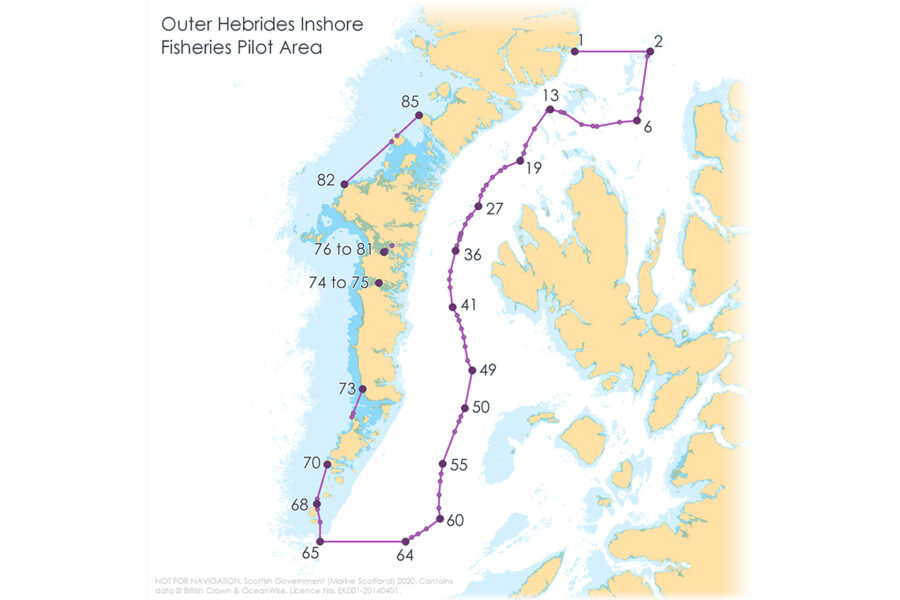Creel limits pilot starts in Outer Hebrides
Scheme to manage effort and build shellfish stocks
A pilot creel limitation scheme east of the Outer Hebrides started on 5 November and will run for two years until 1 November, 2022, reports Tim Oliver.
The Outer Hebrides Inshore Fisheries Pilot will limit the number of creels that can be used in an area east of the Outer Hebrides from the Butt of Lewis to Barra, to test the practicality of managing creel fishing effort and to enhance shellfish stocks in the longer term.
The Scottish government has worked in partnership with the local fishing industry via regional inshore fisheries groups to develop the pilot scheme.
It will test approaches to improving shellfish stocks and reducing gear conflict within the designated area, and will introduce locally agreed limits on creel numbers and soak time.
It is hoped that the scheme will help to reverse decreasing catch per unit effort in the region associated with increasing numbers of creels being fished to target Nephrops, lobster, and brown and velvet crab.
Fishing in the area will be prohibited, apart from 142 vessels that have been issued with derogations to allow them to fish in the area using creels only. Creel limits are:
- Under-8m vessels – 800
- 8m-10m vessels – 1200
- 10m-12m vessels – 1500
- Over 12m vessels – 1800.
Soak time will be limited to three weeks, and is being introduced to prevent large numbers of creels being set and only periodically hauled to prevent others from fishing in the same area.
Forty vessels will also be testing a low-cost tracking system as part of the Scottish government’s ‘Modernisation of the Inshore Fleet’ programme, paving the way for more responsive fisheries management decision-making.
This pilot will provide the Scottish government with insights into how well a localised approach to modernising inshore fishing is working.
Marine Scotland Science will then analyse data outputs, comparing historical data held on the pilot area to that gathered over the duration of the pilot to measure any notable changes, and there will be an evaluation of the wider social and economic impacts of the pilot for fishers and fishing businesses.
Scottish fisheries and rural economy minister Fergus Ewing said: “The launch of the Outer Hebrides pilot is an important milestone in our work to test and trial new fisheries management arrangements. This pilot will help inform our Future Fisheries Management Strategy, helping to support sustainable growth in the sector and enable coastal communities to make the most of their waters.”

The area covered by the Outer Hebrides creel limit pilot scheme.
Duncan Macinnes of the Outer Hebrides Regional Inshore Fisheries Group (OHRIFG) added: “We welcome the strong support provided by the Scottish government to the OHRIFG in taking forward this innovative approach to the local management of the static-gear fishery in the pilot area.
“The tracking technology fitted to vessels will provide additional information to the Scottish government by identifying fishing effort and catches from more localised grounds.
“Hopefully, the findings from the pilot can be used to extend the principle of local management of creel fisheries to other inshore areas around Scotland.”
A Scottish government spokesperson told Fishing News: “We have been working to ensure all members of the fleet are aware of the new measures which come into force on 5 November, and that those who wish to be considered for inclusion in the pilot have had time to apply.
“We analysed records submitted by fishers to understand what vessels had a history of fishing for crab, lobster and Nephrops within the pilot area, and have so far issued 142 letters of derogation to licensed Scottish fishing vessels, to allow them to fish using creels within the pilot area.
“We have a comprehensive eligibility and applications policy that will ensure fair and equitable consideration is given to other licensed fishing vessels wishing to be considered for inclusion in the pilot. Any licence holder wishing to be considered for the pilot should do so through the local fishery office or by emailing: inshore@gov.scot.”
The Outer Hebrides Inshore Fisheries Pilot is one of three inshore pilot schemes that were approved out of seven submitted when the Scottish government asked the industry in 2017 to put forward proposals for alternative management arrangements in Scottish inshore waters.
The other two were for a crabbing box off Mull and a creel box off Arbroath. The Mull box aims to trial the seasonal separation, between 1 October and 31 January, of mobile and static gear, along with a limit on static-gear effort to protect the local brown crab fishery.
The Scottish government spokesperson said: “The Mull crab box concluded its two-year cycle in September, and following feedback from our stakeholder networks was renewed for a third and final year in October.
“The Arbroath pilot that was approved during the 2017 inshore fisheries pilots initiative did not reach agreement between the diverse fishing interests present during its developmental phase.
“However, Marine Scotland has continued to engage with industry-led initiatives in that area, working towards voluntary agreements on spatial and temporal separation of the mobile and static fishing sectors.”








